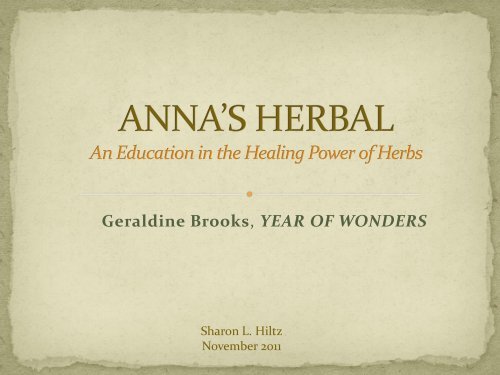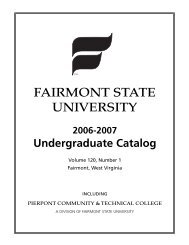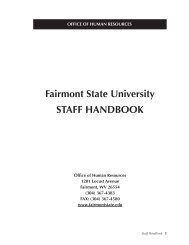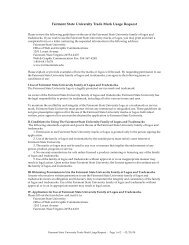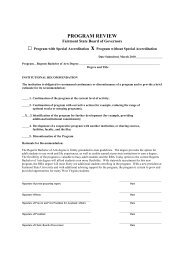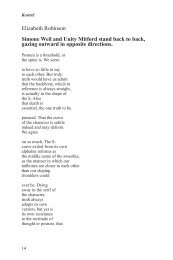Anna's Herbal by Dr. Sharon Hiltz - Fairmont State University
Anna's Herbal by Dr. Sharon Hiltz - Fairmont State University
Anna's Herbal by Dr. Sharon Hiltz - Fairmont State University
You also want an ePaper? Increase the reach of your titles
YUMPU automatically turns print PDFs into web optimized ePapers that Google loves.
Geraldine Brooks, YEAR OF WONDERS<br />
<strong>Sharon</strong> L. <strong>Hiltz</strong><br />
November 2011
Anna Frith and Elinor Mompellion take a<br />
courageous step toward healing their stricken<br />
village when they decide to tap into the healing<br />
properties of common herbs:<br />
“We saw our work as having two natures: the one,<br />
to ease the suffering of the afflicted, and the other,<br />
more important but far less certain in its outcome,<br />
to bolster up the defenses of the well” (YW 165).
Late 17 th century English herbal<br />
knowledge combined traditional,<br />
time-honored “wise-woman” lore with<br />
the ancient advice of such 10 th century<br />
physicians as Dioscorides and<br />
Avicenna.
This is a sample leaf from<br />
one of many manuscripts of<br />
the Materia Medica of<br />
Dioscorides. The herb<br />
depicted is the Bramble, or<br />
blackberry.<br />
Figure 1. Dioscorides, De<br />
Materia Medica. Osborn, David<br />
K. “Dioscorides: Master<br />
<strong>Herbal</strong>ist, Father of Pharmacy.”<br />
Who’s Who in Greek Medicine.<br />
2010. Greek Medicine.net. 5 Oct.<br />
2011<br />
http://www.greekmedicine.net/w<br />
hos_who/Dioscorides.html.
Well before 1666, a number of English<br />
herbals had appeared, among them<br />
John Gerard’s <strong>Herbal</strong>l (1597), John<br />
Parkinson’s Paradisi in Sole (1629), and<br />
Nicholas Culpeper’s The English<br />
Physician (1652). These herbals,<br />
although enjoying wide popularity, may<br />
not have been available in remote<br />
villages such as Eyam.
The first edition of Gerard’s<br />
<strong>Herbal</strong>l appeared in 1597.<br />
Figure 2. “John Gerard –<br />
<strong>Herbal</strong>ist and Scoundrel.”<br />
Growing Hermione’s Garden.<br />
26 Mar. 2011. 5 Oct. 2011<br />
http://hermionesgarden.blogsp<br />
ot.com/2011/03/john-gerardherbalist-and-scoundrel.html.
John Parkinson’s 1629 edition<br />
of Paradisi in Sole earned him<br />
the title of Botanicus Regius<br />
Primarius to King Charles I.<br />
Figure 3. Rohde, Eleanor<br />
Sinclair. The Old English<br />
<strong>Herbal</strong>s. 6 Sept. 2010. Project<br />
Gutenberg. 5 Oct. 2011<br />
http://www.gutenberg.org/files<br />
/33654/33654-h/33654h.htm#chap06.
The first printing of Culpeper’s<br />
The English Physician appeared in<br />
1652.<br />
Figure 4. “Vaulted Treasures.”<br />
Historical Collections at the<br />
Claude Moore Health Sciences<br />
Library. 2007. <strong>University</strong> of<br />
Virginia. 5 Oct. 2011<br />
http://historical.hsl.virginia.edu/tr<br />
easures/culpeper.html.
Avicenna’s Canon of Medicine had been translated from<br />
Arabic into Latin as early as the 12 th century. Numerous<br />
Latin translations of his five-volume treatise were available<br />
in Europe <strong>by</strong> the middle of the 17 th century, primarily in the<br />
medical universities.<br />
In Michael Mompellion’s library, Anna and Elinor are<br />
fortunate to find a volume containing the work of this 10 th<br />
century Arab physician to help them determine how to use<br />
the various herbs left behind <strong>by</strong> village healers Mem and<br />
Anys Gowdie.<br />
Later, Anna takes this Latin volume with her to Oran. She<br />
learns ultimately to read Avicenna’s (Ibn Sina’s) writings in<br />
the original Arabic.
This is the opening leaf to a 15 th<br />
century Arabic manuscript of<br />
Avicenna’s Canon of Medicine.<br />
Figure 5. “Catalogue: Medical<br />
Encyclopedias.” Islamic Medical<br />
Manuscripts at the National<br />
Library of Medicine. 12 June<br />
2008. U.S. National Library of<br />
Medicine. 5 Oct. 2011<br />
http://www.nlm.nih.gov/hmd/ar<br />
abic/E8.html.
Guided <strong>by</strong> her recollection of some of the<br />
Gowdies’ remedies, along with her own<br />
intuition and common sense, Anna learns<br />
to apply herbs in a variety of ways,<br />
progressing from simple infusions and<br />
decoctions to more complex salves,<br />
syrups, and ointments.
“That morning I found [Mrs.<br />
Mompellion] on her knees,<br />
deadheading the daisies. ‘Good<br />
morning, Anna,’ she said as she saw<br />
me. ‘Did you know that the tea made<br />
of this unassuming little flower serves<br />
to cool a fever?’” (YW 36)
Infusion is <strong>by</strong> far the simplest method of using<br />
an herb. Typically the preparer has already<br />
dried the part of the herb to be used – leaves,<br />
bark, or root – and now places an amount of it<br />
in a drinking vessel. She then pours hot-toboiling<br />
water over it and lets the herbal tea<br />
steep for a few minutes until it reaches<br />
sufficient strength.
DAISY (Day’s Eye, Lawn Daisy,<br />
English Daisy; Bellis perennis)<br />
Gerard recommends the leaves and<br />
roots of Daisy for fevers; Mrs.<br />
Grieve’s A Modern <strong>Herbal</strong> (1931),<br />
notes that today’s applications have<br />
not changed.<br />
Figure 6. Sturm, Johann Georg.<br />
Deutschlands Flora in<br />
Abbildungen. Stuttgart, 1796. In<br />
Stueber, Kurt. BioLib Online<br />
Library of Biological Books.<br />
2007. KurtStueber.de. 8 Oct. 2011<br />
http://www.biolib.de/.
“…the smoke was sweet-scented, for the<br />
Gowdies always burned rosemary, which<br />
they said purified the air of any sickness<br />
that ailing villagers might unwittingly<br />
carry when coming there for help.”<br />
(YW 51)
The herbal practitioner lights a small<br />
bundle of the dried twigs or stems of an<br />
herb and “smokes” or “smudges” an area<br />
that needs to be cleansed of evil,<br />
negativity, or illness. Herbs whose natural<br />
fragrance is particularly pungent, such as<br />
sage, cedar, juniper, or rosemary, would<br />
have the greatest protective power.
ROSEMARY (Rosmarinus<br />
officinalis)<br />
Rosemary had been burned in<br />
sickrooms since ancient times,<br />
according to Mrs. Grieve.<br />
Figure 7. Kohler, F. E. Kohler’s<br />
Medizinal-Pflanzen in<br />
naturgetreuen Abbildungen mit<br />
kurz erlauterndem Texte: Atlas<br />
zur Pharmacopoea germanica.<br />
Gera-Untermhaus: F. E. Kohler, 1883-<br />
1914. In Freeland, Chris. Rare Books<br />
from the MBG Library. 2010.<br />
Missouri Botanical Garden. 25 May<br />
2011<br />
http://www.illustratedgarden.org.
“Anys knelt now amidst a clump of glossy green<br />
stems. Each tall stalk held a cluster of buds opening<br />
into blooms of midnight-blue. She was digging at<br />
the roots … ‘It is a handsome plant,’ I said.<br />
“ ‘Handsome – and potent,’ she replied. ‘They call it<br />
wolf’s bane, but it is bane to more than those poor<br />
creatures. Eat a small piece of this root and you will<br />
be dead <strong>by</strong> nightfall.’<br />
“‘Why do you have it here, then?’ …<br />
“‘The wort, ground and mixed with oils, makes a very<br />
good rub for aching joints…’” (YW 51-52)
The herbalist makes an ointment <strong>by</strong><br />
blending the dried root or leaves of an herb<br />
with an oil as a carrier. Alternatively, she<br />
may prepare the ointment using a<br />
decoction or infusion of a single herb or<br />
combination of herbs.<br />
CAUTION: Wolf’s Bane (also known as<br />
Monkshood or Aconite) is highly toxic.<br />
Do not use this herb.
WOLF’S BANE (Monkshood;<br />
Aconitum napellus)<br />
Although Gerard and Mrs. Grieve<br />
note that a liniment made from this<br />
herb eases rheumatism, all parts of<br />
Monkshood are poisonous. DO<br />
NOT USE.<br />
Figure 8. Jacquin, Nikolaus Joseph<br />
et al. Florae Austriaecae, sive,<br />
Plantarum selectarum in<br />
Austriae archiducatu. Vienna:<br />
Leopoldi Joannis Kaliwoda, 1773-78.<br />
In Freeland, Chris. Rare Books<br />
from the MBG Library. 2010.<br />
Missouri Botanical Garden. 25 May<br />
2011<br />
http://www.illustratedgarden.org.
“[Anys] handed me a glass of strong-<br />
smelling brew…It was an unappealing<br />
shade of pale green, with an even paler<br />
froth atop it. ‘Nettle beer. It will<br />
strengthen your blood,’ Anys said. ‘All<br />
women should drink it daily.’<br />
The flavor, as I sipped, was mild and not<br />
unpleasant, while the effect on my tired<br />
body was refreshing.” (YW 52-53)
An herb, water, sugar, yeast, and a little bit<br />
of time…these ingredients produce a<br />
fermented drink that keeps longer than an<br />
herbal infusion. Less labor-intensive and<br />
exacting than wine-making, brewing beer is<br />
a fairly simple way not only to preserve an<br />
herb’s properties but to ensure that those in<br />
need of healing would look forward to<br />
taking their medicine.
NETTLE (Stinging Nettle; Urtica<br />
dioica)<br />
Prized for its astringent properties,<br />
Nettle has been used since early<br />
times as a tonic, a stimulant, a<br />
blood-purifier, and a remedy<br />
against ague.<br />
Figure 9. Jacquin, Nikolaus Joseph et<br />
al. Florae Austriaecae, sive,<br />
Plantarum selectarum in Austriae<br />
archiducatu. Vienna: Leopoldi<br />
Joannis Kaliwoda, 1773-78. In<br />
Freeland, Chris. Rare Books from<br />
the MBG Library. 2010. Missouri<br />
Botanical Garden. 25 May 2011<br />
http://www.illustratedgarden.org.
“‘…[Anys] said, ‘Sometimes a<br />
woman needs a draught of nettle<br />
beer to wake her up, and<br />
sometimes she needs a dish of<br />
valerian tea to calm her down.’”<br />
(YW 54)
The herbalist continues to rely<br />
upon simple preparations to<br />
achieve a particular result.
VALERIAN (Garden Heliotrope;<br />
Valeriana officinalis)<br />
Valerian is still used today as a<br />
relaxant and sleep aid.<br />
Figure 10. Kohler, F. E. Kohler’s<br />
Medizinal-Pflanzen in<br />
naturgetreuen Abbildungen mit<br />
kurz erlauterndem Texte: Atlas<br />
zur Pharmacopoea germanica.<br />
Gera-Untermhaus: F. E. Kohler,<br />
1883-1914. In Freeland, Chris.<br />
Rare Books from the MBG<br />
Library. 2010. Missouri Botanical<br />
Garden. 25 May 2011<br />
http://www.illustratedgarden.org.
“In the morning, Anys brought a<br />
cordial that she said was decocted<br />
from the tops of feverfew with a little<br />
wormwood in sugared sack.” (YW 82)
The herbal practitioner who wants to make<br />
a stronger product than an herbal infusion<br />
will boil an amount of dried herb in water<br />
for a length of time. She will mix an<br />
amount of the resulting decoction with a<br />
sweet liquid such as wine or cordial to make<br />
the medicine more palatable.
FEVERFEW (Febrifuge Plant;<br />
Chrysanthemum parthenium)<br />
Feverfew receives its name from the<br />
Latin febrifuge, which means<br />
literally to put a fever to flight.<br />
Figure 11. Jaume Saint-Hilaire,<br />
Jean Henri. La flore et la pomone<br />
francaises. Paris: Chez l’auteur,<br />
rue Furstemberg, 1828-1833. In<br />
Freeland, Chris. Rare Books from<br />
the MBG Library. 2010. Missouri<br />
Botanical Garden. 25 May 2011<br />
http://www.illustratedgarden.org.
WORMWOOD (Artemisia<br />
absinthium)<br />
A very bitter herb, Wormwood<br />
historically has been used to<br />
stimulate the appetite and to<br />
combat fever and debilitation.<br />
Figure 12. Jaume Saint-Hilaire,<br />
Jean Henri. La flore et la<br />
pomone francaises. Paris: Chez<br />
l’auteur, rue Furstemberg, 1828-<br />
1833. In Freeland, Chris. Rare<br />
Books from the MBG Library.<br />
2010. Missouri Botanical Garden.<br />
25 May 2011<br />
http://www.illustratedgarden.org.
“[Anys] had also brought a cooling salve<br />
fragrant of mint, and she asked me if she<br />
might apply it to the child to lower his<br />
fever.” (YW 82-83)
Making a salve is similar to making an<br />
infusion, except that instead of using water<br />
as the “carrier,” the herbal practitioner will<br />
use a fat or a wax, such as beeswax. She will<br />
mix the leaves or roots of an herb with the<br />
carrier and heat or boil the mixture to<br />
ensure that the herb’s properties leach into<br />
it. The product is intended for external<br />
rather than internal use.
MINT (Peppermint; Mentha<br />
piperita)<br />
Peppermint, used externally, has<br />
cooling and anesthetic properties.<br />
Figure 13. Kohler, F. E. Kohler’s<br />
Medizinal-Pflanzen in<br />
naturgetreuen Abbildungen<br />
mit kurz erlauterndem Texte:<br />
Atlas zur Pharmacopoea<br />
germanica. Gera-Untermhaus:<br />
F. E. Kohler, 1883-1914. In<br />
Freeland, Chris. Rare Books<br />
from the MBG Library. 2010.<br />
Missouri Botanical Garden. 25<br />
May 2011<br />
http://www.illustratedgarden.org.
“[Mem Gowdie] had asked, when she<br />
was still able to speak, for a comfrey<br />
salve on her wounded face.” (YW 95)
The herbal practitioner can use safely a<br />
wide variety of herbs in salves or ointments<br />
that could be potentially harmful if taken<br />
internally.
COMFREY (Symphytum<br />
officinale)<br />
Also known as “Farmer’s Friend,”<br />
Comfrey is still used in soothing<br />
skin preparations. Ironically, it can<br />
be carcinogenic if taken internally,<br />
but has cancer-fighting qualities in<br />
external applications.<br />
Figure 14. Kohler, F. E. Kohler’s<br />
Medizinal-Pflanzen in<br />
naturgetreuen Abbildungen mit<br />
kurz erlauterndem Texte: Atlas zur<br />
Pharmacopoeia Germanica. Gera-<br />
Untermhaus: F. E. Kohler, 1883-1914.<br />
In Freeland, Chris. Rare Books from<br />
the MBG Library. 2010. Missouri<br />
Botanical Garden. 25 May 2011<br />
http://www.illustratedgarden.org.
“‘I have here some poppy if her pain is<br />
great.’<br />
“‘I shook my head at that. ‘Mrs.<br />
Mompellion, I do not think we should<br />
give her poppy, for labor is not called<br />
labor <strong>by</strong> chance. A woman must do<br />
much real work to get her ba<strong>by</strong> born.<br />
We would be sore pressed if she were<br />
fallen into a poppy stupor.’” (YW 119)
The herbalist makes a tincture <strong>by</strong> steeping<br />
the part of the herb to be used – in this<br />
case, resin from the seed-heads of the<br />
opium poppy – in potable alcohol for a few<br />
weeks. The product can be used on its own<br />
or may be added to another liquid.
Anna at this point resists the<br />
temptation to use poppy to relieve a<br />
villager’s labor pains. Later, however,<br />
she makes herself a tea from some<br />
poppy resin stolen from Elinor<br />
Mompellion. The resulting<br />
somnolence takes her away –<br />
temporarily – not only from the<br />
suffering all around her, but from her<br />
own deep grief.
POPPY (Opium Poppy; Papaver<br />
somniferum)<br />
The latex extracted from unripe<br />
Poppy heads has been valued for its<br />
pain-relieving, sedating, and mindaltering<br />
qualities. Modern opiates<br />
include codeine and morphine.<br />
Figure 15. Kohler, F. E. Kohler’s<br />
Medizinal-Pflanzen in<br />
naturgetreuen Abbildungen mit<br />
kurz erlauterndem Texte: Atlas zur<br />
Pharmacopoeia Germanica. Gera-<br />
Untermhaus: F. E. Kohler, 1883-1914.<br />
In Freeland, Chris. Rare Books from<br />
the MBG Library. 2010. Missouri<br />
Botanical Garden. 25 May 2011<br />
http://www.illustratedgarden.org.
“Something brushed my face and I<br />
gasped, but it was just a frond of<br />
meadowsweet that had loosed itself from<br />
a bunch hanging <strong>by</strong> the door.” (YW 144)
The herbalist hangs bunches of aromatic herbs<br />
such as lavender, rosemary, mint, or<br />
meadowsweet to dry. The sweet fragrance of<br />
their branches would freshen stale household<br />
air. Meadowsweet, commonly used in<br />
infusions to combat a number of ailments, was<br />
appreciated most for its scent, a combination<br />
of almond and wintergreen.
MEADOWSWEET (Queen of the<br />
Meadow; Spiraea filipendula)<br />
One of three herbs prized <strong>by</strong> the<br />
<strong>Dr</strong>uids, Meadowsweet was used not<br />
only as an air-freshener, but to treat<br />
diarrhea and ague. Mrs. Grieve<br />
indicates that it is still used against<br />
fevers.<br />
Figure 16. Hayne, F. G. et al.<br />
Getreue Darstellung und<br />
Beschreibung der in der<br />
Arzneykunde gebrauchlichen<br />
Gewachse. Berlin: Kosten des<br />
Verfassers, 1837. In Corwin, James.<br />
Classic Nature Prints. N.d. 7 Oct.<br />
2011<br />
http://www.classicnatureprints.com/<br />
pr.Hayne.Botanicals/hayne.spiraea.fil<br />
ipendula.html.
“[Mrs. Mompellion] stood up then,<br />
reached into a pipkin in the corner, and<br />
measured a quantity of crumbled<br />
chamomile into a pot. The kettle<br />
hanging in the hearth had begun to<br />
steam. From it, she poured just enough<br />
water to make a pungent tea.” (YW 147)
What method is Mrs. Mompellion<br />
using to make her chamomile tea?
CHAMOMILE (Ground Apple;<br />
Anthemis nobilis)<br />
Chamomile is still valued as a<br />
mild sedative, tonic, and<br />
stomach-soother.<br />
Figure 17. Kohler, F. E. Kohler’s<br />
Medizinal-Pflanzen in<br />
naturgetreuen Abbildungen<br />
mit kurz erlauterndem Texte:<br />
Atlas zur Pharmacopoeia<br />
Germanica. Gera-Untermhaus:<br />
F. E. Kohler, 1883-1914. In<br />
Freeland, Chris. Rare Books<br />
from the MBG Library. 2010.<br />
Missouri Botanical Garden. 25<br />
May 2011<br />
http://www.illustratedgarden.org<br />
.
“Eventually we discovered that the best …<br />
was a volume <strong>by</strong> one Avicenna, a<br />
Musalman doctor who, many years since,<br />
had set down all his learning in a vast<br />
canon… Nettle for the blood. Starwort<br />
and violet leaves for the lungs.<br />
Silverweed to cool a fever. Cress for the<br />
stomach. The worts of blow-ball for the<br />
liver, bat-weed for the glands, and vervain<br />
for the throat.” (YW 154-155)
These herbs would be known as “simples;”<br />
that is, the practitioner uses only one herb<br />
at a time, regardless of preparation method,<br />
for a single purpose.
STARWORT (Chickweed,<br />
Starweed; Stellaria media)<br />
The humble Chickweed has been<br />
used in infusions to relieve<br />
coughs.<br />
Figure 18. Harding, Samuel, John<br />
Nourse, and Elizabeth Blackwell. A<br />
Curious <strong>Herbal</strong>. London: Printed<br />
for John Nourse, 1739. In Freeland,<br />
Chris. Rare Books from the MBG<br />
Library. 2010. Missouri Botanical<br />
Garden. 25 May 2011<br />
http://www.illustratedgarden.org.
VIOLET (Sweet Violet; Viola<br />
odorata)<br />
Culpeper notes that Violet is<br />
efficacious against diseases of the<br />
lungs; according to Mrs. Grieve,<br />
this herb is still used to relieve<br />
coughs.<br />
Figure 19. Rousseau, Jean-Jacques.<br />
Recueil de plantes colorees, pour<br />
server a l’intelligence des letters<br />
elementaires sur la botanique.<br />
Paris: Poincot, 1789. In Freeland,<br />
Chris. Rare Books from the MBG<br />
Library. 2010. Missouri Botanical<br />
Garden. 25 May 2011<br />
http://www.illustratedgarden.org.
SILVERWEED (Potentilla,<br />
Goosewort; Potentilla anserina)<br />
Historically used as a treatment for<br />
ague, Silverweed remains a<br />
valuable febrifuge.<br />
Figure 20. Sturm, Johann<br />
Georg. Deutschlands Flora in<br />
Abbildungen. Stuttgart, 1796.<br />
In Stueber, Kurt. BioLib Online<br />
Library of Biological Books.<br />
2007. KurtStueber.de. 8 Oct.<br />
2011 http://www.biolib.de/.
CRESS (Watercress;<br />
Sisymbrium nasturtium<br />
aquatica)<br />
Watercress, another of the<br />
<strong>Dr</strong>uids’ most sacred herbs, earns<br />
credit from both ancient and<br />
modern herbalists as an appetite<br />
stimulant.<br />
Figure 21. Houttoyn, Martinus.<br />
Afbeeldingen der artsenygewassen<br />
met dervelver<br />
Nederduitsche en Latynsche<br />
beschryvingen, Tweede deel.<br />
Amsterdam: J. C. Sepp en Zoon,<br />
1796. In Stueber, Kurt. BioLib<br />
Online Library of Biological<br />
Books. 2007. KurtStueber.de. 8<br />
Oct. 2011 http://www.biolib.de/.
BLOWBALL (Dandelion;<br />
Taraxacum officinale)<br />
The common Dandelion continues to<br />
be useful against disorders of the<br />
liver, according to Mrs. Grieve.<br />
Figure 22. Kohler, F. E. Kohler’s<br />
Medizinal-Pflanzen in<br />
naturgetreuen Abbildungen mit<br />
kurz erlauterndem Texte: Atlas<br />
zur Pharmacopoeia Germanica.<br />
Gera-Untermhaus: F. E. Kohler,<br />
1883-1914. In Freeland, Chris. Rare<br />
Books from the MBG Library.<br />
2010. Missouri Botanical Garden.<br />
25 May 2011<br />
http://www.illustratedgarden.org.
BAT-WEED (Burdock;<br />
Arctium lappa)<br />
Early and modern herbalists<br />
note the value of Burdock as a<br />
tonic, diuretic, and bloodpurifier.<br />
Figure 23. Blackwell,<br />
Elizabeth, et al. Herbarium<br />
Blackwellianum.<br />
Nuremberg: Typis Io. Iosephi<br />
Fleischmanni, 1750-1773. In<br />
Freeland, Chris. Rare Books<br />
from the MBG Library. 2010.<br />
Missouri Botanical Garden.<br />
25 May 2011<br />
http://www.illustratedgarden.<br />
org.
VERVAIN (Verbena officinalis)<br />
The third of the <strong>Dr</strong>uids’ most<br />
sacred herbs, Vervain has been<br />
used since ancient times to fight<br />
ague, ulcers, and fevers.<br />
Figure 24. Blackwell, Elizabeth, et<br />
al. Herbarium Blackwellianum.<br />
Nuremberg: Typis Io. Iosephi<br />
Fleischmanni, 1750-1773. In<br />
Freeland, Chris. Rare Books from<br />
the MBG Library. 2010. Missouri<br />
Botanical Garden. 25 May 2011<br />
http://www.illustratedgarden.org.
“…we began to learn some of what [the<br />
Gowdies] had known: that a compound<br />
of mullein and rue, sweet cicely and<br />
mustard oil makes an excellent syrup for<br />
quieting a cough; that boiled willow bark<br />
eases aches and fevers; that betony,<br />
bruised for a green plaster, speeds<br />
mending of wounds and scrapes.”<br />
(YW 165)
The herbalist produces a syrup through compounding<br />
an assortment of herbs with complementary properties<br />
and then sweetening the result with sugar or, as is<br />
more likely in Anna Frith’s case, with honey.<br />
Once again, we see the practitioner making a<br />
decoction of a single herb.<br />
Herbs such as comfrey or betony contain chemicals<br />
believed to heal external wounds. The herbal<br />
practitioner will bruise, chop, or shred the fresh leaves<br />
and place the resulting plaster on the affected part to<br />
facilitate healing.
MULLEIN (Aaron’s Rod;<br />
Verbascum thapus)<br />
Mrs. Grieve concurs with Gerard<br />
that Mullein is useful for a variety<br />
of ills, including treating coughs<br />
and soothing sore throats.<br />
Figure 25. Blackwell, Elizabeth,<br />
et al. Herbarium<br />
Blackwellianum. Nuremberg:<br />
Typis Io. Iosephi Fleischmanni,<br />
1750-1773. In Freeland, Chris.<br />
Rare Books from the MBG<br />
Library. 2010. Missouri<br />
Botanical Garden. 25 May 2011<br />
http://www.illustratedgarden.org.
RUE (Ruta graveolens)<br />
The value of Rue as an<br />
emetic and antispasmodic<br />
led it to be used in cough<br />
remedies.<br />
Figure 26. Weinmann, Johann<br />
Wilhelm, et al. Phytanthoza<br />
iconographia. Regensburg: Per<br />
Hieronymum Lentzium, 1737-1745.<br />
In Freeland, Chris. Rare Books<br />
from the MBG Library. 2010.<br />
Missouri Botanical Garden. 25<br />
May 2011<br />
http://www.illustratedgarden.org.
SWEET CICELY (Myrrhis<br />
odorata)<br />
An expectorant, Sweet Cicely has<br />
been used to treat coughs.<br />
Figure 27. “Myrrha odorante.<br />
Myrrhis odorata. Sweet Cicely.”<br />
Elixirs floraux de la<br />
Bourrache. Illustrations. N.d.<br />
25 May 2011<br />
http://www.florelixir.net/htm<br />
illus/Myrrhis.html.
MUSTARD (White Mustard;<br />
Brassica spp.)<br />
Whether used externally or<br />
internally, Mustard has been a<br />
traditional remedy for bronchitis<br />
and sore throat.<br />
Figure 28. Kohler, F. E. Kohler’s<br />
Medizinal-Pflanzen in<br />
naturgetreuen Abbildungen<br />
mit kurz erlauterndem Texte:<br />
Atlas zur Pharmacopoeia<br />
Germanica. Gera-Untermhaus:<br />
F. E. Kohler, 1883-1914. In<br />
Freeland, Chris. Rare Books<br />
from the MBG Library. 2010.<br />
Missouri Botanical Garden. 25<br />
May 2011<br />
http://www.illustratedgarden.org.
WILLOW (White Willow; Salix<br />
alba)<br />
Our modern aspirin contains<br />
salicylic acid, a substance found in<br />
Willow bark.<br />
Figure 29. Jaume Saint-Hilaire, Jean<br />
Henri. Traite des arbres<br />
forestiers. Paris: Firmin Didot,<br />
1824. In Freeland, Chris. Rare<br />
Books from the MBG Library.<br />
2010. Missouri Botanical Garden. 25<br />
May 2011<br />
http://www.illustratedgarden.org.
BETONY (Wood Betony;<br />
Betonica officinalis)<br />
Culpeper recommends Betony<br />
leaves as a plaster to heal various<br />
wounds.<br />
Figure 30. Blackwell, Elizabeth,<br />
et al. Herbarium<br />
Blackwellianum. Nuremberg:<br />
Typis Io. Iosephi Fleischmanni,<br />
1750-1773. In Freeland, Chris.<br />
Rare Books from the MBG<br />
Library. 2010. Missouri<br />
Botanical Garden. 25 May 2011<br />
http://www.illustratedgarden.org.
“The bramble leaf itself has that in it<br />
to soothe its own thorns’ pricks, so I<br />
compounded some with silverweed<br />
and comfrey and a little cooling mint<br />
and bound the result with almond oil.<br />
It was a sweet-smelling ointment…”<br />
(YW 212)
When Anna’s herbal education<br />
began, she relied upon Elinor<br />
Mompellion and Anys Gowdie for<br />
help. Now she is able to blend an<br />
ointment on her own, using oil of<br />
the sweet almond as the carrier for<br />
the other herbs.
BRAMBLE (Blackberry; Rubus<br />
fruticosus)<br />
Gerard notes the astringent<br />
properties of Bramble, which make<br />
it particularly useful for a number<br />
of skin conditions.<br />
Figure 31. Blackwell, Elizabeth.<br />
Herbarium Blackwellianum.<br />
Nuremberg: Typis Io. Iosephi<br />
Fleischmanni, 1750-1773. In<br />
Freeland, Chris. Rare Books from<br />
the MBG Library. 2010. Missouri<br />
Botanical Garden. 25 May 2011<br />
http://www.illustratedgarden.org.
ALMOND (Sweet Almond;<br />
Amygdalus communis)<br />
Gerard extols the emollient<br />
properties of Almond oil, wellknown<br />
since ancient times and<br />
still prized today.<br />
Figure 32. Jaume Saint-Hilaire,<br />
Jean Henri. Traite des<br />
arbrisseaux et des arbustes<br />
cultives en France. Paris: chez<br />
l’auteur, 1825. In Freeland, Chris.<br />
Rare Books from the MBG<br />
Library. 2010. Missouri Botanical<br />
Garden. 25 May 2011<br />
http://www.illustratedgarden.org.
Anna Frith’s herbal journey through the Plague Year begins with<br />
Elinor Mompellion and Anys Gowdie telling her about the uses and<br />
properties of particular herbs.<br />
After the deaths of Mem and Anys Gowdie, Anna must recall what<br />
these healers had done with the herbs they had grown and gathered.<br />
Once Elinor teaches her to read, Anna can research for herself how<br />
other herbalists have applied their knowledge.<br />
Ultimately, Anna exhibits enough confidence and sophistication to<br />
compound her own herbal remedies.<br />
Anna builds upon her knowledge of healing herbs in her new life in<br />
Oran, Algeria:<br />
“As I continue to study and learn, I hope to accomplish a worthy life’s<br />
work here. I am reading Avicenna now, or Ibn Sina, as I have correctly<br />
learned to call him. I am reading his writings not in Latin, as I had<br />
imagined, but in Arabic.” (YW 302)
The Canon of Medicine of Avicenna. New York: AMS Press, n.d. Internet<br />
Archive. 8 Oct. 2011<br />
http://www.archive.org/stream/AvicennasCanonOfMedicine/9670940-Canonof-Medicine_djvu.txt.<br />
“Catalogue of Medical Encyclopedias.” Islamic Medical Manuscripts at the<br />
National Library of Medicine. 12 June 2008. U. S. National Library of<br />
Medicine. 5 Oct. 2011 http://www.nlm.nih.gov/hmd/arabic/E8.html.<br />
Culpeper, Nicholas. The Complete <strong>Herbal</strong>. N.d. Bibliomania.com. 8 Oct. 2011<br />
http://www.bibliomania.com/2/1/66/113/frameset.html.<br />
Culpeper’s Complete <strong>Herbal</strong> Alphabetical Index. 2010. Complete-herbal.com. 8<br />
Oct. 2011 http://www.complete-herbal.com/completeherbal1814.htm.<br />
Dioscorides. <strong>Herbal</strong> (extracts). MS Bodl. 130. Bodleian Library, U. of Oxford. 8 Oct.<br />
2003. Bodleian Library. 5 Oct. 2011<br />
http://www.bodley.ox.ac.uk/dept/scwmss/wmss/medieval/mss/bodl/130.htm#catinfo.
Freeland, Chris. Rare Books from the MBG Library. 2010. Missouri<br />
Botanical Garden. 8 Oct. 2011 http://www.illustratedgarden.org.<br />
Gerard’s <strong>Herbal</strong>, or The Generall Historie of Plantes. 1633. Ed. Ollivander,<br />
Holly and Huw Thomas. Velluminous Press, Dec. 2008. Gerardsherbal.com. 8<br />
Oct. 2011 http://www.gerardsherbal.com.<br />
Grieve, Mrs. M. A Modern <strong>Herbal</strong>. 2011. Botanical.com. 8 Oct. 2011<br />
http://www.botanical.com/botanical/mgmh/mgmh.html.<br />
Ibn Sina [Avicenna]. Kitab al Qanoun fi Al Toubb (The Book of the Canon<br />
of Medicine). Rome: The Medical Press, 1593. AUB Libraries, 2007. 8 Oct.<br />
2011 http://ddc.aub.edu.lb/projects/saab/avicenna/english.html.<br />
“John Gerard – <strong>Herbal</strong>ist and Scoundrel.” Growing Hermione’s Garden. 26<br />
Mar. 2011. Blogspot.com. 5 Oct. 2011<br />
http://www.hermionesgarden.blogspot.com/2011/03/john-gerard-herbalistand-scoundrel.html.
Kaldera, Raven. Northern Tradition Shamanism <strong>Herbal</strong>. 2004. Raven Kaldera. 8<br />
Oct. 2011 http://www.northernshamanism.org/herbal/index.html.<br />
Rohde, Eleanor Sinclair. The Old English <strong>Herbal</strong>s. 6 Sept. 2010. Project Gutenberg.<br />
5 Oct. 2011 http://www.gutenberg.org/files/33654/33654-h/33654-h.htm.<br />
Stueber, Kurt. BioLib Online Library of Biological Books. 2007. KurtStueber.de. 8<br />
Oct. 2011 http://www.biolib.de/.<br />
“Vaulted Treasures.” Historical Collections at the Claude Moore Health Sciences<br />
Library. 2007. <strong>University</strong> of Virginia. 5 Oct. 2011<br />
http://www.historical.hsl.virginia.edu/treasures/culpeper.html.<br />
Zajaczkowa, Jadwiga. <strong>Herbal</strong>ism, Medieval, Magickal, and Modern. N.d.<br />
Gallowglass.org. 8 Oct. 2011 http://www.gallowglass.org/jadwiga/herbs/herbs.html.<br />
---. Herbs and Spices of the Middle Ages. N.d. Gallowglass.org. 8 Oct. 2011<br />
http://www.gallowglass.org/jadwiga/herbs/herbbooks.html.<br />
---. Links to Online <strong>Herbal</strong> Resources. N.d. Gallowglass.org. 8 Oct. 2011<br />
http://www.gallowglass.org/jadwiga/herbs/herblinks.html.


